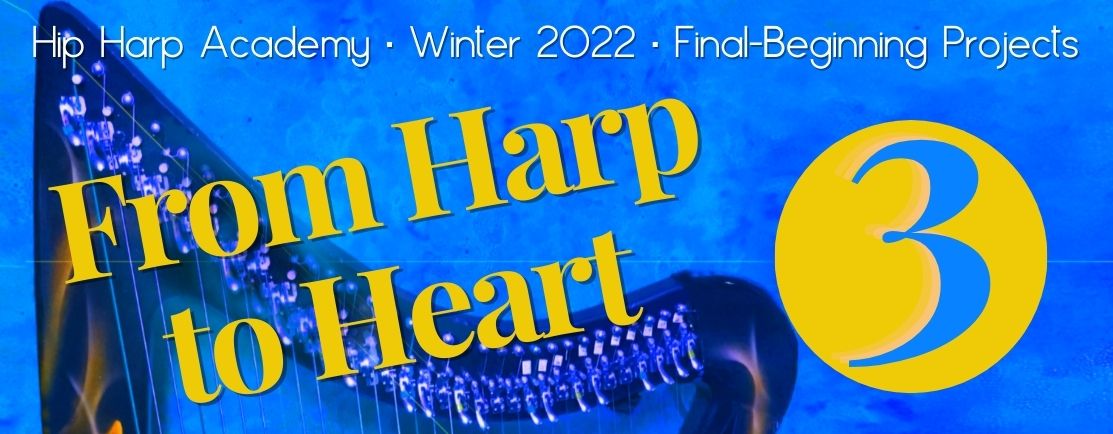
WELCOME to Part 3 of the Hip Harp Academy
Final-Beginning Projects ~ Winter 2022
How to enjoy these video shares
How to enjoy these wonderful video shares? Enjoy the creativity and the willingness to share. Think about the fact that each of these videos is a unique creation – none of these musicians are playing written sheet music – they’ve created these arrangements by learning the fundamentals of arrangement and improvisation and putting them into play – literally – in their own creations.
Read their own account of their personal creative journey in creating each video by clicking the toggle beneath each video – and I encourage you to do that if you really want to be inspired.
Some of the players have played for years, and even decades – some have come to the harp as adults – some even as a retirement gift for themselves. We’re a community connected by a commitment to creative expression. Every week we meet for masterclasses and training, during the week we practice the new ideas and the willingness to be vulnerable, authentic and self-expressed with our instruments, our voices and ourSELVES.
What if you decided to explore a new way of playing music, where you learned the basic building blocks of music itself, and then you ‘built’ a new piece every time you played?
That’s what members of “Hip Harp Academy” learn to do – to build and discover music as they’re playing, and let it be new each time, without the security-blanket of the notes on the page.
Enjoy these video shares from the 2022 Fall program at Hip Harp Academy where our motto is “Connection … not Perfection”
Click the toggle beneath each video to read the personal creative journey of each player – and if you play the harp, join us at Hip Harp Academy.
See All the Winter 2022 Projects:
Projects #1 – Projects #2 – Projects #3
Louise Bell:
Creativity is glorious!
Louise's Insights about this Project
Describe your final project so I know exactly what you’re sending me.
Structure is Freedom. Final Beginning Project
What principles from this course or from chats did you use to develop, perform, and record this project – and how did they play a part in your process?
I found the 5 part Arrangement process really engaging, and it inspired this recording.
Give a short description of what it took for you to be able to play what you did – both logistically and emotionally.
The melodic & harmonic inspirations arrived during the 5 part arrangement segment, and deepened in the recent Chat, where DHC asked us to think of messages and concepts, inspiring me to connect intentions to each of the 5 parts.
What freedoms and blocks within yourself did you connect with (or struggle with) in the process?
I felt free and exhilarated exploring melody, harmony & arrangement. I struggled with my initial inspiration of blending glissandi & block chords for the Outro, but just couldn’t play it so I compromised!
What challenges did you meet while connecting with your own freedom of expression in this project?
Felt relaxed playing and evolving this. The challenges arrive when the camera is on!
What other parts of your life were impacted by what you learned in this class, and how?
Early mornings are entirely worthwhile to connect with HHA! Creating the time/space to set up backdrop, lighting, quiet moments to record, can be challenging AND rewarding!
What were your personal “Ahas”?
Creativity is glorious!
Tara:
I think the idea of some structure serving as a platform for wide-ranging exploration is a powerful one. It helps me understand other people’s creative endeavors (in many fields) and can apply in my own life beyond just music, such as in cooking. A structure of pasta and vegetables allows for a lot of possibilities.
Tara's Insights about this Project
Describe your final project so I know exactly what you’re sending me.
This is a meditative improvisation on the folk tune,
“Dona, Dona.” The melody should be recognizable to those who know it, but the harmonies are highly non-traditional.
What principles from this course or from chats did you use to develop, perform, and record this project – and how did they play a part in your process?
In keeping with the quarter’s theme, “Structure is Freedom,” I used a folk melody as a framework for harmonic improvisation. Specifically, I was interested in exploring more jazzy harmonies. I used the “trick” of slowing down in a musical way to give myself time to think as I played.
Give a short description of what it took for you to be able to play what you did – both logistically and emotionally.
I had to train myself somewhat to accept unexpected (and sometimes dissonant) accompaniment. I felt frustrated sometimes that I would also lose the melody in my wanderings, but I found I could refocus by sometimes playing only the melody in both hands or by dropping the RH and singing the melody instead. (The video doesn’t show those parts.) Initially, I was trying to think fairly theoretically about the chords, but at DHC’s suggestion, I tried to focus more on hand shapes and just listen as I moved the shapes around. I found that I had an interesting tonal palette with just one preset lever, and although I could explore flipping levers mid-piece, I didn’t need to.
What freedoms and blocks within yourself did you connect with (or struggle with) in the process?
I generally give myself permission to make slow, uneven progress, but there were times when I questioned my wisdom in tackling this project. It wasn’t always clear to me what I was really learning, or whether I would come up with a version of this piece that anyone would want to listen to. But eventually I started learning what kinds of notes I mostly wanted to avoid, and then I could explore the rest pretty freely.
What challenges did you meet while connecting with your own freedom of expression in this project?
While I was trying to keep a familiar melody, I had to keep reminding myself that “familiar” harmonies were not what I was after, and that it was okay for the result to be a big departure from the traditional. I also found I needed to go back to the traditional rendering occasionally for a moment of mental relaxation.
What other parts of your life were impacted by what you learned in this class, and how?
I think the idea of some structure serving as a platform for wide-ranging exploration is a powerful one. It helps me understand other people’s creative endeavors (in many fields) and can apply in my own life beyond just music, such as in cooking. A structure of pasta and vegetables allows for a lot of possibilities.
What were your personal “Ahas”?
It’s okay to not always have a clear idea of the “finished” product. I can have a rich tonal palette with very few lever changes.
Is there anything else you want people to know when they watch your video?
To me this piece feels very meditative and wistful. It is based on the Yiddish/klezmer song, “Dona, Dona,” which contrasts a mournful calf going to market with a swallow flying on the laughing winds.
Cherie:
I’ve always wanted to sing & play with the harp and with Deborah’s teaching, I can do this.
Cherie's Insights about this Project
Describe your final project so I know exactly what you’re sending me.
Sing & Play “You are my Sunshine”.
What principles from this course or from chats did you use to develop, perform, and record this project – and how did they play a part in your process?
I used the 5 part arrangement. I did a swing “feel” to this tune and used stride bass in the improv. Everything I’ve used for this video is from the class & courses, especially the sing & play course.
Give a short description of what it took for you to be able to play what you did – both logistically and emotionally.
The biggest achievement for me was to be able to sing & play, something I couldn’t do before joining the academy.
What freedoms and blocks within yourself did you connect with (or struggle with) in the process?
The freedom to know how to change a key that I can sing with. Using the numbers, 1 5 4 , so I could try out different keys to see what works. I found that the Key of G was better for me.
What challenges did you meet while connecting with your own freedom of expression in this project?
The challenge to play chords and rhythm while singing. Whenever I practice playing I always sing and this has helped.
What other parts of your life were impacted by what you learned in this class, and how?
I used to sing all the time when I was a child and I’ve found myself singing every day now which makes me feel happy. I am just so thrilled that I can actually sing & play.
What were your personal “Ahas”?
While playing about I found by doing the pivot in the right hand I could get a swing rhythm in the melody. I really liked this, changing the sound of a well known tune.
Is there anything else you want people to know when they watch your video?
I’ve always wanted to sing & play with the harp and with Deborah’s teaching, I can do this.
Felicity:
Pare back to the essentials- simplify! Don’t overcomplicate unnecessarily.
Felicity's Insights about this Project
Describe your final project so I know exactly what you’re sending me.
This is a wee lullaby I’ve composed for a harp friend’s baby – I had the idea in the final week of her pregnancy. I also imagined that Mary might have sung a simple lullaby such as this to her infant son, hence the title: lullaby for ‘bump’/Mary’s song. Certainly not perfect but created with love.
What principles from this course or from chats did you use to develop, perform, and record this project – and how did they play a part in your process?
I took on board the mantra, ‘it’s about connection not perfection’ and kept my project submission simple so that it was achievable
Give a short description of what it took for you to be able to play what you did – both logistically and emotionally.
I just had to self-commit to creating something for the final beginnings project with little time to do it. I decided to record this lullaby that I composed last week. I challenged myself to sing it too which stretched my comfort zone even further!
What freedoms and blocks within yourself did you connect with (or struggle with) in the process?
It’s not as flowing as I’d like but I’m learning that ‘good enough’ shared is better than not sharing. I just have to let it go and move on from here
What challenges did you meet while connecting with your own freedom of expression in this project?
I’d like to feel more relaxed when sharing and recording -I guess I just have to keep doing it.
What other parts of your life were impacted by what you learned in this class, and how?
Pare back to the essentials- simplify! Don’t overcomplicate unnecessarily
What were your personal “Ahas”?
I am beginning to believe that I can sing and play harp. Retrieving my long lost voice.
Carol B:
This has been huge for me, to aspire to make a video where I use my voice and harp.
I now believe that I can do this
Carol's Insights about this Project
Describe your final project so I know exactly what you’re sending me.
This is my very first attempt to combine voice and harp. This is the fourth ‘take’.
The title is “90 Seconds of Mindfulness – Well a bit more really”
I’d intended to do this as my half-bake, but life got in the way.
So, I pushed on to do is as my final project (sorry it’s late).
I thought that in this busy world it would be a useful thing to offer a 90 second meditation. I didn’t achieve that. It’s about two and a half minutes.
The harp is totally in the moment improv.
My questions for coaching are:
– Does it work? (would you find it a useful meditation video?)
– Is the harp complimentary or distracting?
– Is there anything that needs to change to make this a good thing to offer others?
What principles from this course or from chats did you use to develop, perform, and record this project – and how did they play a part in your process?
- Have a go! It’s about connection not perfection! Even if you can’t do the perfect thing you want to do (at this stage), do something!
• Make it simple and slow.
• Breathe!
• Make it harp from the heart.
Give a short description of what it took for you to be able to play what you did – both logistically and emotionally.
- I wasn’t able to focus my attention on harp playing and also on speaking at the same time. I had to trust that my hands would do something, and that it would be appropriate.
• Life has been insane around here and I couldn’t put the time I wanted to in. I had to be prepared to sit down and just ‘wack something out’ in a short time, or I wouldn’t have submitted anything.
What freedoms and blocks within yourself did you connect with (or struggle with) in the process?
- The stumbling blocks: “my voice isn’t good enough”, “it will sound clumsy”, “it will sound pretentious”, “I don’t have the right to teach this” “I don’t look right for this.”
• The freedom: just ignore the voices in your head and do it anyway!
What challenges did you meet while connecting with your own freedom of expression in this project?
Just actually physically making the time to get sat on the harp stool and to set up the camera.
What other parts of your life were impacted by what you learned in this class, and how?
This has been huge for me, to aspire to make a video where I use my voice and harp.
I now believe that I can do this (this clip might not be perfect, but I can see that I can get there.)
Also, since I set the aspiration for this project, I’ve begun to sing. And that’s huge.
What were your personal “Ahas”?
I can trust my fingers.
Is there anything else you want people to know when they watch your video?
Yes, I know that if I say it will be 90 seconds, it needs to be 90 seconds.
I know I need to re-do this and make it 90 seconds, or alternatively, state the correct amount of time.
Harpists Who Dare!
Are you ready to free yourself from the notes on the page?
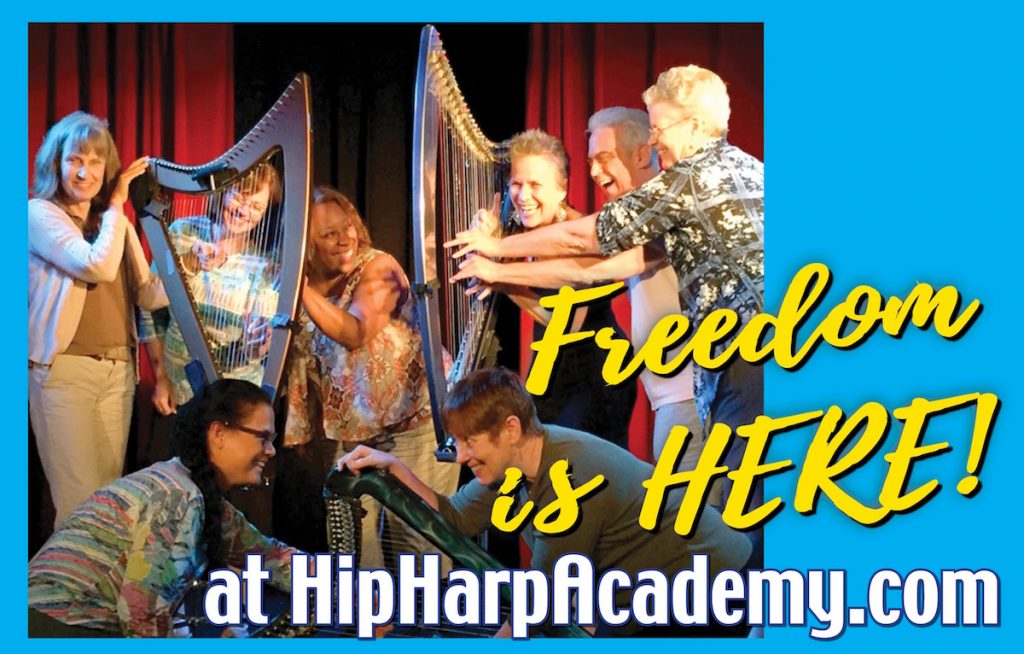
Join NOW and GET $400 OFF until Midnight Jul. 31
Cathy Hornby:
Linking melodies with little themes and musical bridges was fun and the first time I managed this
Cathy's Insights about this Project
Describe your final project so I know exactly what you’re sending me.
Here’s a video of ‘Santa Lucia’, marks the feast day of 13th December.
I was introduced to the traditions followed in Sweden on St Lucia’s day by a harpist friend and I resolved to learn to play it in time for this year. My project included making an arrangement and using motifs from a couple of other melodies. I wanted to make it suitable for a gift for an old friend of mine whose birthday is on that day, hence his name, Lucidio. I knew him way back in the 1970s and only realised the significance of his name when I learned about the saints day celebration those couple of years ago. I think/hope he’ll be really touched by the recording!
What principles from this course or from chats did you use to develop, perform, and record this project – and how did they play a part in your process?
In my rather longer version I used vamps and a coke of the chord/finger shapes learned in the live classes and the overall form is advised by using the intro-tune-outro form. I used a couple of other melodies in my longer version too, blending in themes from ‘A Day Like This’ by Elbow, and a deconstructed jingle bells (Joni M got there first of course). I find using the snippets vey inspirational, I play around freely with them and usually something suggests itself to me from them and then I build an arrangement from there.
Give a short description of what it took for you to be able to play what you did – both logistically and emotionally.
This was, as usual, hard for me. I get really relaxed playing in the impro sessions on Mondays, and I get full of ideas and encouragement. Then I try to pin them down a bit and it all goes to hell! I need space to get on with the projects, but practically I only have the room to myself a couple of evenings so it’s tricky. I soooooo wanted to get something in this time so I’m delighted to have managed something, even if it’s not what I played before hitting the record button. It is an achievement for me to keep going when my fingers don’t go where they were meant to, but I’m pleased that I can and just pretend that they were the notes I intended! I like the idea of ‘pretending you can do it’ – it really helps! I have to do a lot of shushhhing to the critical voices in my head, but I’m always delighted to get something done in spite of it! I’m pretending I can do this, right?!
What freedoms and blocks within yourself did you connect with (or struggle with) in the process?
Freedom? Hmmmm…to feel it’s ok to drop one idea and run with another, not to be so committed to it that it can’t change.
Blocks – the usual, fear of the recording button, and finding time and physical space to make a recording.
What challenges did you meet while connecting with your own freedom of expression in this project?
Relaxing – I play freely when relaxed and make my best music, but I tense up when it is to be heard or seen by another and that reduces my playing to around a quarter of its potential.
What other parts of your life were impacted by what you learned in this class, and how?
I have a good few Christmas tunes since I procrastinated so much re what I would settle to and work on, and a piece to share with my St Lucia enthusiast friends!
What were your personal “Ahas”?
Linking melodies with little themes and musical bridges was fun and the first time I managed this (though it’s not properly showcased in my submission)
Is there anything else you want people to know when they watch your video?
It was dark so it’s rather grainy, but the candles are specifically linked with the feast of St Lucia, so it had to be that way!
Nancy Brockman:
Simple is better, especially for my patients. I have a tendency to play too fast and mechanically. So when I slow down and let each string “sing” my playing takes on a different quality…
Nancy's Insights about this Project
Describe your final project so I know exactly what you’re sending me.
The project is focused on developing a presentation featuring the baxic principles contained in this quarter’s teachings. It is how I internalized many levels of the teachings even though I can’t absorb many of the details. That is why it is so great to be in the Academy for the second year. There is a platform to grow from to a higher level.
Describe your written materials – if there’s anything in particular you want to say about it to help people know what they’re looking at, add that here.
I have chosen to include the words from this ancient carol. It fits so well the mood and meaning.
What principles from this course or from chats did you use to develop, perform, and record this project – and how did they play a part in your process?
They are: 1) the 5-part arrangement form, 2) developing the harmony and rhythm ; 3)especially the chord progressions and extensions from the snippets which are the major building block for me.
Give a short description of what it took for you to be able to play what you did – both logistically and emotionally.
Logistically, it was finding a melody that spoke to me and developing a harmonic structure and variations. It took a lot of exploration to come up what worked for me. Emotionally, it was a respnse to the mystery of the lowered 7th degree which elevated the melody to a mystical realm through the Mixolydian mode and tempo rubato.
What freedoms and blocks within yourself did you connect with (or struggle with) in the process?
With so many options, it meant trying to be somewhat consistent enough to establish a pattern. I play it differently every time. I especially resonated with the modal change in the short part B.
What challenges did you meet while connecting with your own freedom of expression in this project?
None, really. I felt I could take the piece in many different directions. I struggle with the stress of the video, since what I envision is seldom realized when I replay the video.
What other parts of your life were impacted by what you learned in this class, and how?
This class opened up numerous opportunites for me in playing for the end-of-life patients at Transitions Life Care Hospice Home. Also I recognized how to utilize the freedom in this playing that did not require using actual melodies, especially recognizable melodies which can trigger unintended and upsetting memories in my patients.
What were your personal “Ahas”?
Simple is better, especially for my patients. I have a tendency to play too fast and mechanically. So when I slow down and let each string “sing” my playing takes on a different quality, which is really to take people to a different place.
Is there anything else you want people to know when they watch your video?
Star of the East is an old Christmas Carol, attributed to Bishop Reginald Heber in 1811. It was popular in England and eventually made it into the Appalachian highlands and into the Shape Note Tradition. Although the shape note vocalists would probably have sung it in strict rhythm, I have interpreted it as a lyrical air. The unique tonal qualities seem to pierce the realm of reality.
Melinda Ostrander-Aviles:
I wasn’t sure what to do for this project. I decided to submit something that was a requirement for an improv class I have been taking. I used the concepts of keeping things simple and connection, not perfection.
Melinda's Insights about this Project
What principles from this course or from chats did you use to develop, perform, and record this project – and how did they play a part in your process?
I wasn’t sure what to do for this project. Since I haven’t been feeling well and have been very busy, I decided to submit something that was a requirement for an improv class I have been taking. I used the concepts of keeping things simple and connection, not perfection.
Give a short description of what it took for you to be able to play what you did – both logistically and emotionally.
I have never been comfortable singing and had vowed that I wasn’t ever going to put myself out there. However, singing was a requirement for this project in my other class. It was not optional.
What freedoms and blocks within yourself did you connect with (or struggle with) in the process?
This is completely improvised and unrehearsed and will never be repeated in the same way. The requirement was to play piano (but I used harp), then add voice and then another instrument. There were also some other parameters. It is sort of avant garde and relaxing at the same time.
What challenges did you meet while connecting with your own freedom of expression in this project?
I had to get over my fear and loathing of singing for anyone. I managed to do all the tracks basically in one take, with no “do overs.” And even though I have some notes in there that I normally would not have let pass, I let go of my urge to do more takes.
What other parts of your life were impacted by what you learned in this class, and how?
The classes are ALWAYS inspirational and I get so much from the snippets and from everyone else’s sharing.
What were your personal “Ahas”?
This has been a freeing experience…the singing, and the “one take” recording. I feel like I can do more things like this in the future.
Is there anything else you want people to know when they watch your video?
Since I recently got a new electric harp, I recorded directly into the SoundTrap program. This is a video of what that looks like.
Julia Cunningham:
I became so aware of structure this term that I continuously found myself thinking of a piece in terms of its structure. I truly understand now that “structure (absolutely!) is freedom.”
Julia's Insights about this Project
Describe your final project so I know exactly what you’re sending me.
This is my final beginning project for “Structure is Freedom.”
Describe your written materials – if there’s anything in particular you want to say about it to help people know what they’re looking at, add that here.
This is a video for my harp cover of “O Christmas Tree.” I’d like to share this musical Christmas greeting with family and friends.
What principles from this course or from chats did you use to develop, perform, and record this project – and how did they play a part in your process?
The principle of sharing in the academy is what inspired me to create this video because I felt so motivated and inspired by what my fellow classmates have shared.
Give a short description of what it took for you to be able to play what you did – both logistically and emotionally.
I’ve been wanting to make a video of my cover of “O Christmas Tree” for quite some time but didn’t feel confident to do so myself.
Through a lot of trial and error and many, many hours of learning, editing, etc, I’m happy to say that “I did it” and, in the end, I actually enjoyed the process!
What freedoms and blocks within yourself did you connect with (or struggle with) in the process?
Through our weekly snippets I’m reminded of how great it feels to play freely and without expectations, or pressure.
As far as blocks go, I often struggle with self doubt. I love that Deborah always encourages us to “find something we love” when we’re watching each other’s projects. I should probably do the same with regards to my own playing & projects.
What challenges did you meet while connecting with your own freedom of expression in this project?
My biggest challenge this term was simply trying to find the time and the energy to keep up with the program. I always look forward to the connection, interesting discussions and inspiration I’m gifted with each week in the academy. The HHA truly is a bright spot in my life for which I’m truly grateful.
What other parts of your life were impacted by what you learned in this class, and how?
I’m amazed at how the HHA seeps into my life in different ways. I’ve had the intention of creating music videos for years and, thanks to the structure of the academy, I finally found the inspiration and drive to do so.
I also find that having a project deadline gives me the drive to complete things.
Being faced with a deadline seems to inspire creativity as one strives to reach creative potential within a set amount of time.
What were your personal “Ahas”?
I became so aware of structure this term that I continuously found myself thinking of a piece in terms of its structure. I truly understand now that “structure (absolutely!) is freedom.”
Is there anything else you want people to know when they watch your video?
I just hope you enjoy it and that it touches you in some way.
Eily Aurora:
Thank you DHC and the team for all your energy. This academy is so welcoming and this welcoming energy makes me realize i am enough and what I do is worth sharing and making public within this community.
Eily's Insights about this Project
Describe your final project so I know exactly what you’re sending me.
A Looping piece I am preparing for this weekend’s two shows. I aim to create the structure with loops so that I can just flow with my voice more intuitively. I took a snippit from one of the written practices that I love and modulated it to Dorian.
What principles from this course or from chats did you use to develop, perform, and record this project – and how did they play a part in your process?
Looping, snippits, intuitive movement with playing, smiling and playing, improv over a rhtyhm, the 5 part arrangement structure
Give a short description of what it took for you to be able to play what you did – both logistically and emotionally.
Definitely practice! I have been working with the looper for a while. Practice is essential in getting a base structure before a performance. It took me really beliving in myself and how important it is to sing during a performance. If I don’t create the structure beforehand at a show (compared to a sound ceremony) my throat can close up with fear.
What freedoms and blocks within yourself did you connect with (or struggle with) in the process?
The willingness to fail. To look silly trying a new way of sharing musically. To really honor the need for structure/support in order for my inner child/inner lover to be expressive freely infront of a big group.
What challenges did you meet while connecting with your own freedom of expression in this project?
That I won’t sound good. I will look like I am not prepared or just not competant as a musician at all. FAILURE>
What other parts of your life were impacted by what you learned in this class, and how?
It could really impact my willingness to share my voice, stories and energy in public again in a performance setting. To allow for the inutiive flow as well as more prepared songs is vital for my wellbeing now.
What were your personal “Ahas”?
PRACTICE the looper and I will get better at it.
Find the joy in the music. That is what I will practice. When there is joy, I want to practice it and repeat it over and over again.
Ask for help and have a pre audience. I did this a few nights ago and really got some great feedback, which super helped my confidence levels as I step into an unknown audience space.
Is there anything else you want people to know when they watch your video?
Thank you DHC and the team for all your energy. This academy is so welcoming and this welcoming energy makes me realize i am enough and what I do is worth sharing and making public within this community.
Are you OK with me sharing your final project & answers to the 6 questions on my blog (or just sharing your answers to the 6 questions if you didn’t submit a final-beginning project)?
Mona:
Giving is receiving, receiving is giving. Play from my heart. Stop being afraid to not belong like I feel every day.
Mona's Insights about this Project
Describe your final project so I know exactly what you’re sending me.
Giving and receiving. I learned a lot in this class, here’s an impromptu first take of my meditation idea using my gift from Richard who passed this summer, Romantic Richard.
It’s raw, it’s me, and I gave and received
What principles from this course or from chats did you use to develop, perform, and record this project – and how did they play a part in your process?
Intro body play melody conclusion, and anything that happens. Is okay whether it sounds good or not to me.
Give a short description of what it took for you to be able to play what you did – both logistically and emotionally.
Grieving, living, learning, allowing, courage, heart.
What freedoms and blocks within yourself did you connect with (or struggle with) in the process?
Comparison to others.
What challenges did you meet while connecting with your own freedom of expression in this project?
I did it for my best friend who has always enjoyed my sensual stories that made her respond! Lol
What other parts of your life were impacted by what you learned in this class, and how?
The art of giving and receiving, I always thought I should only allow myself to give and give and give.
What were your personal “Ahas”?
Giving is receiving, receiving is giving. Play from my heart. Stop being afraid to not belong like I feel every day.
Is there anything else you want people to know when they watch your video?
Let yourself go, take notice of all the spectacular moments in your life!
Special Thanks
Very special thanks to harpist Sally Walstrum for collecting and curating these video gifts (including the 30+ others that we’ll be sharing in coming days). Sally – you are a joy and an inspiration. And thanks to everyone in the Academy for your willingness to share your gifts with the world. You make this a richer world to live in. (DHC 12/21/22)
Harpists Who Dare!
Are you ready to free yourself from the notes on the page?

Join NOW and GET $400 OFF until Midnight Jul. 31
PROJECTS & PERFORMANCES:
FOR HARPISTS:
- Join Hip Harp Academy
- Harp Time Live (FREE Weekly Playalong)
- FREE Resources

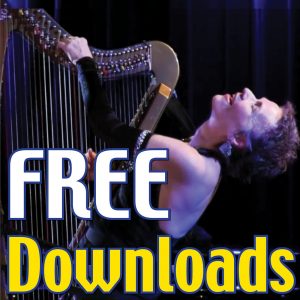
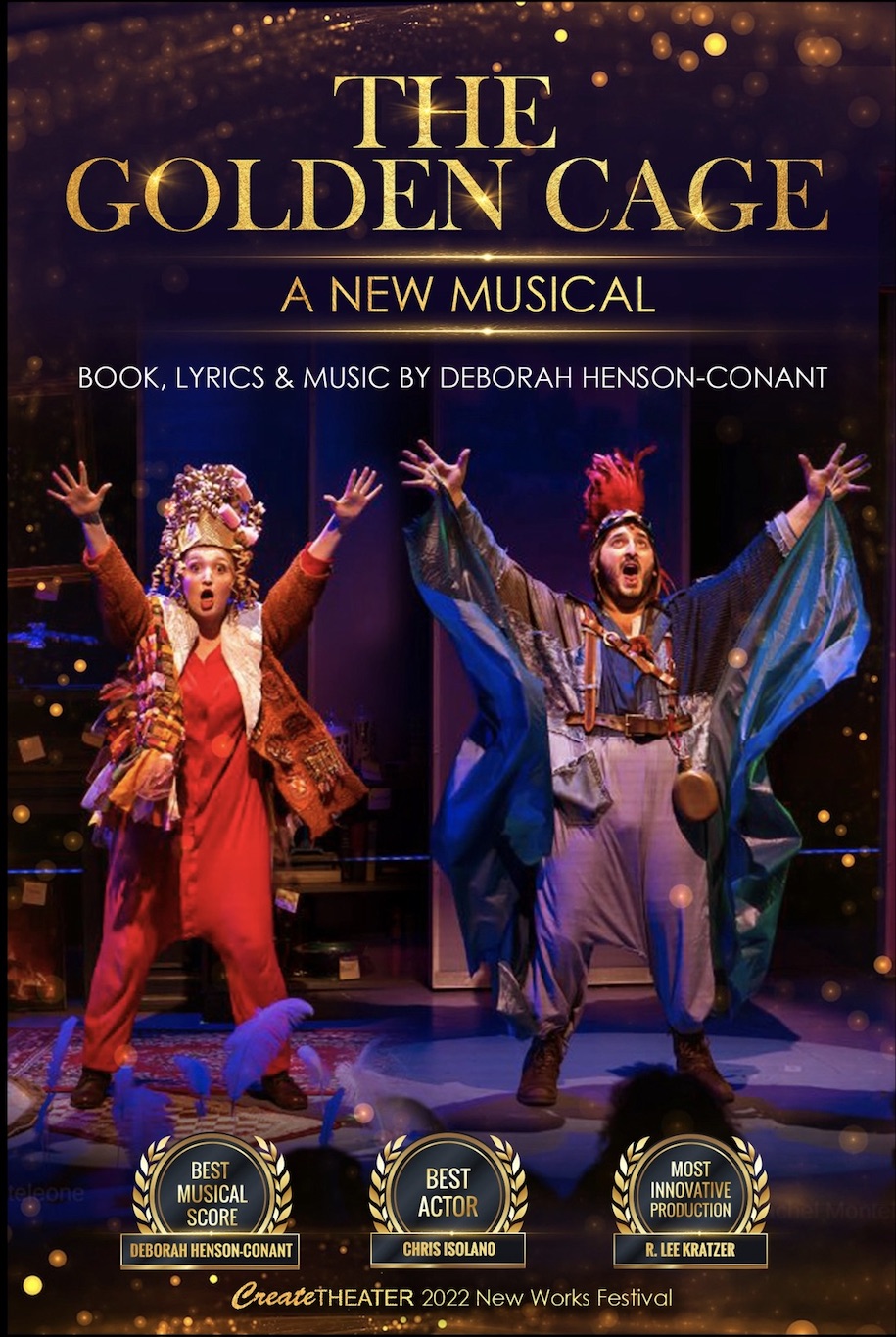
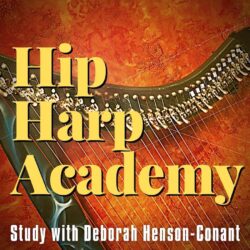
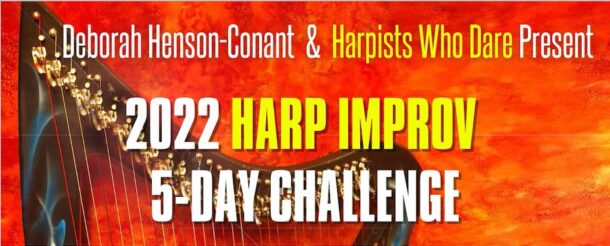
Join for Freebies, Stories & News
Join to get weekly-ish emails with stories, videos & events like concerts & classes
Yay! You should get my next newsletter within the next 7-10 days. I'm so happy we'll be in touch!
I won't ever share your email address with others - and you can unsubscribe anytime, tho most people say they really enjoy these weeklish emails.